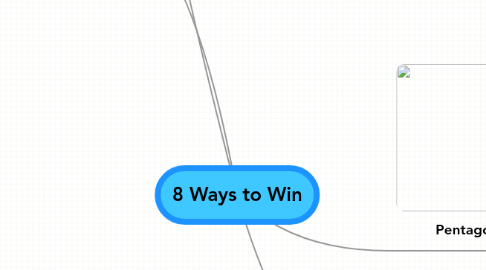
1. Introduction
1.1. How to Use
1.1.1. Map
1.1.1.1. Sustainable Competitive Advantage
1.1.1.2. Retail Format
1.1.1.2.1. Elements of Retail Format Design
1.1.1.2.2. SWOT of Retail Formats
1.1.1.3. Differentiate within a retail format
1.2. Pentagon
1.2.1. Customer facing
1.2.1.1. Aspirational
1.2.2. Market Differentiation
1.2.3. In other words
1.2.3.1. Sell it hard!
1.2.4. Skills
1.2.4.1. Stylist
1.2.4.2. Marketing
1.2.4.3. Communications
1.2.4.4. Artist
1.2.4.5. Salesmanship
1.2.4.6. Shopaholic
1.2.4.7. Sensitive to emotions and feelings
1.3. Triangle
1.3.1. Inward facing
1.3.1.1. Operational
1.3.2. Cost effeciency
1.3.3. In other words
1.3.3.1. Price it hard!
1.3.4. Skills
1.3.4.1. Logistician
1.3.4.2. Statistics
1.3.4.3. Operations Research
1.3.4.4. Business Process Re-engineering
1.3.4.5. Business Analyst
1.3.4.6. Systems integrator
1.3.4.7. Sensitive to numbers and details
2. Triangle
2.1. Systems
2.1.1. What it is
2.1.1.1. A key differentiating system that makes the format work
2.1.2. What it is not
2.1.2.1. It is not "having a computer system"
2.1.3. Examples
2.1.3.1. Walmart - technology to increase items and assortment with small stock effeciently
2.1.3.2. 7-eleven - relayout 3 times a day
2.1.4. Systems
2.1.4.1. Operational Management
2.1.4.1.1. Planning
2.1.4.1.2. Budgeting
2.1.4.1.3. Review
2.1.4.1.4. Performance management
2.1.4.2. Replacement of labour
2.1.4.2.1. Labor scheduling system
2.1.4.2.2. Electronic shelf stickers
2.1.4.2.3. Fully automated warehouse/DC
2.1.4.2.4. Self check out
2.1.4.2.5. Checkout robot
2.1.4.2.6. Store security systems
2.1.4.3. Fast Supply Chain
2.1.4.3.1. Replenishment
2.1.4.3.2. Carton labelling
2.1.4.3.3. Programmed Supply Relationships
2.1.4.3.4. Information sharing
2.1.4.4. Merchandising
2.1.4.4.1. Direct Product Profitability
2.1.4.4.2. Modularisation of store design
2.1.4.5. CRM
2.1.4.5.1. Closed loop loyalty system
2.1.4.6. Consumer credit
2.1.4.6.1. Customer credit system
2.1.4.7. Pre-requisites
2.1.4.7.1. Accounting
2.1.4.7.2. Inventory management
2.1.4.7.3. Point of Sale
2.2. Suppliers
2.2.1. Sourcing toolbox
2.2.1.1. Sources
2.2.1.2. Interaction with source
2.2.1.3. Supplier relationships
2.2.1.4. Stocking of merchandise
2.2.1.5. Geographical market
2.2.1.6. Mode of buying
2.2.1.7. Organisational form
2.2.1.8. Technological form
2.2.2. Sourcing situations
2.2.2.1. dimensions
2.2.2.1.1. complexity
2.2.2.1.2. differentiation
2.2.3. Changing supplier - buyer relationships
2.3. Logistics
2.3.1. mix
2.3.1.1. storage facility
2.3.1.2. goods
2.3.1.3. transporation
2.3.2. management control of the entire supply chain
2.3.3. change in logistics
2.3.3.1. push to pull
2.3.3.1.1. ECR
2.3.4. retail supply chain
2.3.4.1. elements
2.3.4.1.1. manufacturers
2.3.4.1.2. wholesalers
2.3.4.1.3. retailers
2.3.4.1.4. logistic service providers
2.3.4.1.5. customers
2.3.4.2. flow
2.3.4.2.1. goods flow
2.3.4.2.2. money flow
2.3.4.2.3. information flow
3. Pentagon
3.1. Place
3.1.1. Size
3.1.1.1. dimension
3.1.1.1.1. Size of store
3.1.1.2. consistency
3.1.1.2.1. Strengthen brand equity by presenting and delivering a consistent customer experience chain-wide
3.1.2. Location
3.1.2.1. types
3.1.2.1.1. stand-alone
3.1.2.1.2. planned
3.1.2.1.3. unplanned
3.1.2.2. decision process
3.1.2.2.1. geographic
3.1.2.2.2. catchment area
3.1.2.2.3. location assessment
3.1.2.2.4. search techniques
3.1.3. Layout & Design
3.1.3.1. background information
3.1.3.1.1. Shopping Process
3.1.3.1.2. In-Store Marketing
3.1.3.1.3. Good Design and Layout
3.1.3.2. elements
3.1.3.2.1. core
3.1.3.2.2. Store atmosphere
3.1.3.3. retail branding
3.1.3.3.1. memory of store image
3.1.3.3.2. retailers advantage
3.1.3.4. allocation
3.1.3.4.1. by sales
3.1.3.4.2. by profit
3.1.3.4.3. special consideration
3.2. Product
3.2.1. Style & Fashion
3.2.1.1. Adoption
3.2.1.1.1. Innovator
3.2.1.1.2. Early adopter
3.2.1.1.3. Early Majority
3.2.1.1.4. Late Majority
3.2.1.1.5. Laggard
3.2.2. Intensity
3.2.2.1. Stock per sqm
3.2.2.2. Value per sqm
3.2.2.3. Presentation
3.2.2.3.1. Stack em High
3.2.2.3.2. Museum
3.2.3. Assortment
3.2.3.1. Management
3.2.3.1.1. Create the assortment
3.2.3.1.2. Make it work
3.2.3.2. Category Management
3.2.3.2.1. Step 1: Definition
3.2.3.2.2. Step 2: Category role
3.2.3.2.3. Step 3: Category assessment
3.2.3.2.4. Step 4: Performance measures
3.2.3.2.5. Step 5: Category strategies
3.2.3.2.6. Step 6: Tactics
3.2.3.2.7. Step 7: Implementation
3.2.3.2.8. Step 8: Category review and back to step 1
3.2.3.3. Merchandising mix
3.2.3.3.1. Product Lifecycle
3.2.3.3.2. Quality
3.2.3.3.3. Breadth
3.2.3.3.4. Depth
3.2.3.4. Product Brands
3.2.3.4.1. National Brands
3.2.3.4.2. Store Brand
3.3. Value
3.3.1. Price
3.3.1.1. Methods for price setting
3.3.1.1.1. Product Costing
3.3.1.1.2. Cost-oriented
3.3.1.1.3. Competition-oriented
3.3.1.1.4. Demand-oriented
3.3.1.1.5. Price image and positioning
3.3.2. Quality
3.3.2.1. actual product quality
3.3.2.2. perceived brand quality
3.3.3. Brand positioning
3.3.3.1. Strong Retail Brand as the Umbrella brand of manufacturer brand
3.3.3.2. Representative of the customer who is reliable and trust worthy
3.3.3.3. Branding is a space in the customer's mind that is the impression of the Brand
3.4. Communication
3.4.1. Positional
3.4.1.1. Brand
3.4.1.1.1. A brand is a product that adds other dimensions that differentiate it in some way from other products designed to satisfy a need
3.4.1.2. Retail Brand
3.4.1.2.1. Brand + Group of stores
3.4.1.2.2. Comprehensive and integrated marketing management concept focussing on building long-term customer loyalty and customer preference.
3.4.1.3. Strong Retail Brand
3.4.1.3.1. Communication
3.4.1.3.2. Experience
3.4.1.3.3. Consistency in execution
3.4.2. Promotional
3.4.2.1. Customer Relationship Management
3.4.2.1.1. acquisition to retention at lowest cost
3.4.2.1.2. principles
3.4.2.1.3. data mining
3.4.2.1.4. RFM
3.4.2.2. Promotions
3.5. People
3.5.1. Service
3.5.2. Knowledge
3.5.3. Climate
